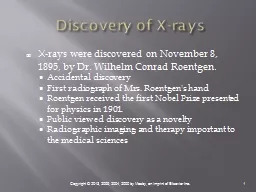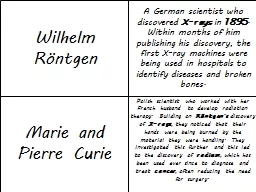PPT-Discovery of X-rays X-rays were discovered on November 8, 1895, by Dr. Wilhelm Conrad
Author : test | Published Date : 2020-04-03
Accidental discovery First radiograph of Mrs Roentgens hand Roentgen received the first Nobel Prize presented for physics in 1901 Public viewed discovery as a novelty
Presentation Embed Code
Download Presentation
Download Presentation The PPT/PDF document " Discovery of X-rays X-rays were discove..." is the property of its rightful owner. Permission is granted to download and print the materials on this website for personal, non-commercial use only, and to display it on your personal computer provided you do not modify the materials and that you retain all copyright notices contained in the materials. By downloading content from our website, you accept the terms of this agreement.
Discovery of X-rays X-rays were discovered on November 8, 1895, by Dr. Wilhelm Conrad: Transcript
Download Rules Of Document
" Discovery of X-rays X-rays were discovered on November 8, 1895, by Dr. Wilhelm Conrad"The content belongs to its owner. You may download and print it for personal use, without modification, and keep all copyright notices. By downloading, you agree to these terms.
Related Documents














